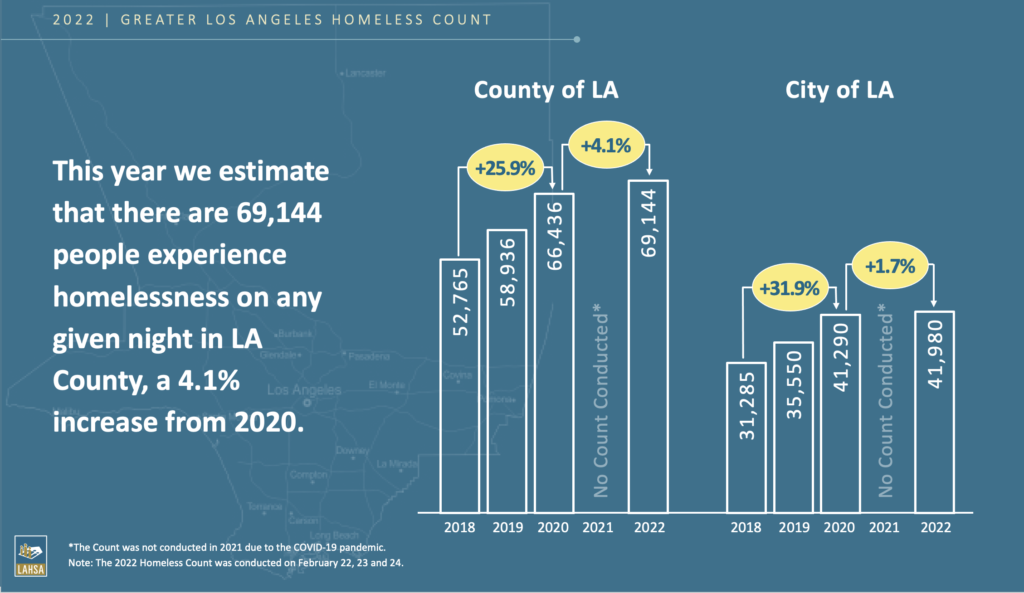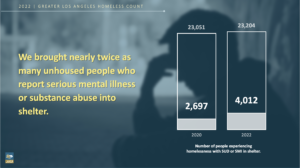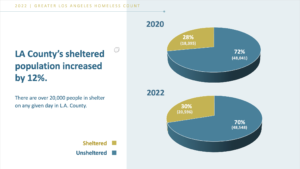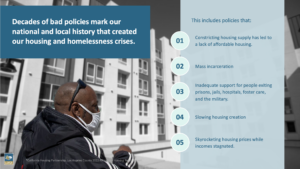Greater Los Angeles Homeless Count Suggests Pandemic-era Policies Prevented Surge in Homelessness
More information available in LAHSA’s press conference presentation, press release, slide deck, and data summaries
The Los Angeles Homeless Services Authority (LAHSA) released the results of the 2022 Homeless Count, which suggest that homelessness may be rising more slowly than in previous years.
The results of the point-in-time count, conducted over three nights in February, estimated that 69,144 people were experiencing homelessness in LA County at that time, a 4.1% rise from 2020, and 41,980 people were experiencing homelessness in the City of LA, up 1.7% from 2020. (A count was not conducted in 2021 due to the COVID pandemic.)
This year’s Homeless Count results offer a stark contrast to the results of the Homeless Counts between 2018 and 2020, where LA County saw a 25.9% increase and the City of LA experienced a 32% increase.

Over the past five years, LAHSA and its partners have made 84,000 permanent housing placements–enough to fill Dodger Stadium one and a half times. Last year alone, the rehousing system made 21,213 placements.
Policies and Investments Limited the Growth of Homelessness
During the pandemic, one-time federal assistance and local economic policies like eviction moratoriums and rentals assistance helped keep people in their homes. Many of those policies and funding sources are now ending, providing fewer resources for the rehousing system to help those who fall into homelessness.
“If there’s one thing you take away from these results, I want you to see how policy and investments matter. Tenant protections and rental assistance helped people stay in their homes and out of homelessness,” said Molly Rysman, Acting Co-Executive Director of LAHSA. “But now our community is in a precarious position. If these policies end, it is entirely possible that future homeless counts could show significant increases. We need those critical policies to continue.”
Thanks to a 62% Increase in Shelter Beds Since 2019, More People are in Shelter Than Ever Before
Across LA County, more people are in shelter than ever before. Shelter is a necessary and vital part of our system because bringing people inside protects them from the destructive effects on their health and safety that comes from experiencing unsheltered homelessness.
 With help from the federal government and the State of California through innovative non-congregate shelter programs like Project Roomkey and Project Homekey, LA County saw a 12% increase in its sheltered population (20,596 people) over 2020, while LA City’s sheltered population grew by 8.7% (13,522 people). The City of LA also saw a 1.4% drop in the number of people experiencing unsheltered homelessness.
With help from the federal government and the State of California through innovative non-congregate shelter programs like Project Roomkey and Project Homekey, LA County saw a 12% increase in its sheltered population (20,596 people) over 2020, while LA City’s sheltered population grew by 8.7% (13,522 people). The City of LA also saw a 1.4% drop in the number of people experiencing unsheltered homelessness.
“These numbers reinforce truths that everyone who works tirelessly on this knows in their hearts and minds: visible and lasting progress can only come through investments in long-term, affordable, and quality housing solutions,” said Mayor Eric Garcetti. “It is encouraging to learn that our efforts to confront this crisis have not been in vain, and I know that if we keep doubling down on the historic investments we’ve made, working together and continue to treat every person living on our streets with compassion and humanity we will become a more resilient, fair, and just city.”
However, the shelter system was still experiencing decompression back in February to ensure social distancing, limiting the number of people it could bring inside.
“These numbers show us how nuanced the homelessness crisis is and the gains that can be made from testing new programs in the face of unprecedented circumstances. The County was able to act swiftly on activating additional sites and beds during COVID-19. We housed almost 8,000 older adults and people most at risk of infection and potential death through Project RoomKey and Project HomeKey. This was possible by partnering with the State to provide funding to hotel and motel owners and our County teams.” Los Angeles County Board of Supervisors Chair, Holly J. Mitchell
The Number of Tents, Makeshift Shelters, and Vehicles Increased, with Fewer People in Them
 Notably, LAHSA noted how the count findings show why the pandemic made homelessness appear more visible than the 4% increase suggests.
Notably, LAHSA noted how the count findings show why the pandemic made homelessness appear more visible than the 4% increase suggests.
This year’s Homeless Count revealed a 17% increase in tents, vehicles, and makeshift shelters on LA County’s streets and sidewalks from 2020–but with fewer people in them. At the same time, LA County’s unsheltered population rose by only 1%. This means LA County saw a significant increase in the evidence of homelessness without a corresponding rise in our unsheltered neighbors. LAHSA leaders indicated this is a result of the LA area following CDC guidance not to remove encampments, to ensure unhoused neighbors could practice social distancing and reduce the spread of COVID-19.
Coming Together to Address Homelessness
Along with the count findings, LAHSA leaders discussed the policy changes all stakeholders must make to move even more people into permanent housing in the years to come.
LAHSA highlighted its efforts to reduce the unsheltered population by increasing the number of people who enter shelter and are placed on a path to permanent housing. The agency will also help elected officials make data-driven decision-making by releasing new key performance indicators at the end of September.
During its presentation, LAHSA also applauded its local government partners for their commitment to increasing the LA area’s inventory of affordable and permanent housing. In particular, LAHSA recognized the City of Los Angeles for its progress in creating more affordable housing in the past five years than the previous 30 and the projection that Prop. HHH will exceed its goal of bringing 10,000 units of affordable and permanent supportive housing online.
LAHSA recommended that every jurisdiction in LA County continue increasing their housing investments. National best practices show that a rehousing system works most effectively to reduce homelessness when there are five permanent housing units available for every shelter bed. LA’s current ratio is one housing exit per shelter bed.
“While it is too soon to know what this year’s count results will mean long-term, the numbers are suggesting there is a flattening of the curve that is driven by the necessary and effective economic programs that helped keep people in their homes throughout the pandemic,” said Kristina Dixon, Acting Co-Executive Director at LAHSA.
Policies and Investments Limited the Growth of Homelessness
 During the pandemic, one-time federal assistance and local economic policies like eviction moratoriums and rentals assistance helped keep people in their homes. Many of those policies and funding sources are now ending, providing fewer resources for the rehousing system to help those who fall into homelessness.
During the pandemic, one-time federal assistance and local economic policies like eviction moratoriums and rentals assistance helped keep people in their homes. Many of those policies and funding sources are now ending, providing fewer resources for the rehousing system to help those who fall into homelessness.
“If there’s one thing you take away from these results, I want you to see how policy and investments matter. Tenant protections and rental assistance helped people stay in their homes and out of homelessness,” said Molly Rysman, Acting Co-Executive Director of LAHSA. “But now our community is in a precarious position. If these policies end, it is entirely possible that future homeless counts could show significant increases. We need those critical policies to continue.”
Thanks to a 62% Increase in Shelter Beds Since 2019, More People are in Shelter Than Ever Before
Across LA County, more people are in shelter than ever before. Shelter is a necessary and vital part of our system because bringing people inside protects them from the destructive effects on their health and safety that comes from experiencing unsheltered homelessness.
With help from the federal government and the State of California through innovative non-congregate shelter programs like Project Roomkey and Project Homekey, LA County saw a 12% increase in its sheltered population (20,596 people) over 2020, while LA City’s sheltered population grew by 8.7% (13,522 people). The City of LA also saw a 1.4% drop in the number of people experiencing unsheltered homelessness.
“These numbers reinforce truths that everyone who works tirelessly on this knows in their hearts and minds: visible and lasting progress can only come through investments in long-term, affordable, and quality housing solutions,” said Mayor Eric Garcetti. “It is encouraging to learn that our efforts to confront this crisis have not been in vain, and I know that if we keep doubling down on the historic investments we’ve made, working together and continue to treat every person living on our streets with compassion and humanity we will become a more resilient, fair, and just city.”
However, the shelter system was still experiencing decompression back in February to ensure social distancing, limiting the number of people it could bring inside.
“These numbers show us how nuanced the homelessness crisis is and the gains that can be made from testing new programs in the face of unprecedented circumstances. The County was able to act swiftly on activating additional sites and beds during COVID-19. We housed almost 8,000 older adults and people most at risk of infection and potential death through Project RoomKey and Project HomeKey. This was possible by partnering with the State to provide funding to hotel and motel owners and our County teams.” Los Angeles County Board of Supervisors Chair, Holly J. Mitchell
The Number of Tents, Makeshift Shelters, and Vehicles Increased, with Fewer People in Them
Notably, LAHSA noted how the count findings show why the pandemic made homelessness appear more visible than the 4% increase suggests.
This year’s Homeless Count revealed a 17% increase in tents, vehicles, and makeshift shelters on LA County’s streets and sidewalks from 2020–but with fewer people in them. At the same time, LA County’s unsheltered population rose by only 1%. This means LA County saw a significant increase in the evidence of homelessness without a corresponding rise in our unsheltered neighbors. LAHSA leaders indicated this is a result of the LA area following CDC guidance not to remove encampments, to ensure unhoused neighbors could practice social distancing and reduce the spread of COVID-19.
Coming Together to Address Homelessness
Along with the count findings, LAHSA leaders discussed the policy changes all stakeholders must make to move even more people into permanent housing in the years to come.
LAHSA highlighted its efforts to reduce the unsheltered population by increasing the number of people who enter shelter and are placed on a path to permanent housing. The agency will also help elected officials make data-driven decision-making by releasing new key performance indicators at the end of September.
During its presentation, LAHSA also applauded its local government partners for their commitment to increasing the LA area’s inventory of affordable and permanent housing. In particular, LAHSA recognized the City of Los Angeles for its progress in creating more affordable housing in the past five years than the previous 30 and the projection that Prop. HHH will exceed its goal of bringing 10,000 units of affordable and permanent supportive housing online.
LAHSA recommended that every jurisdiction in LA County continue increasing their housing investments. National best practices show that a rehousing system works most effectively to reduce homelessness when there are five permanent housing units available for every shelter bed. LA’s current ratio is one housing exit per shelter bed.

